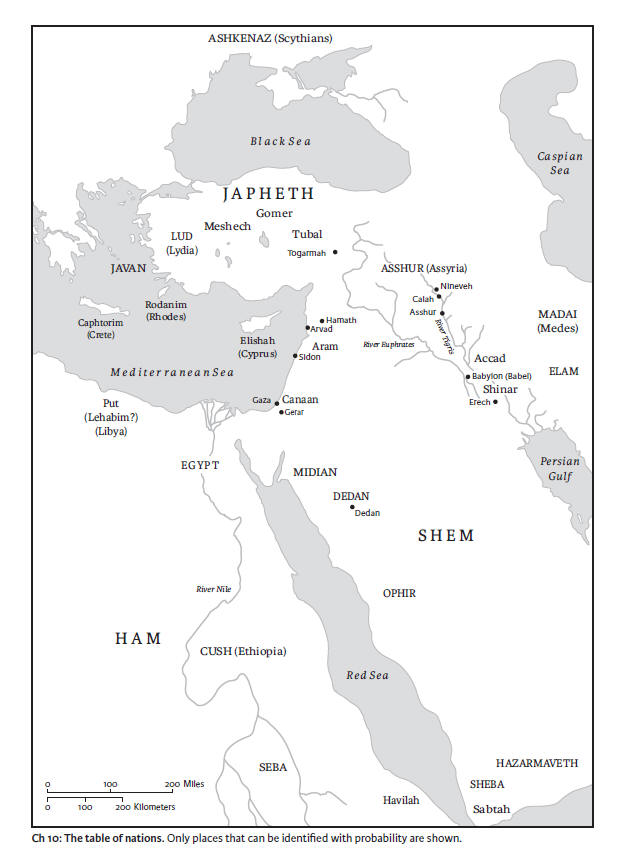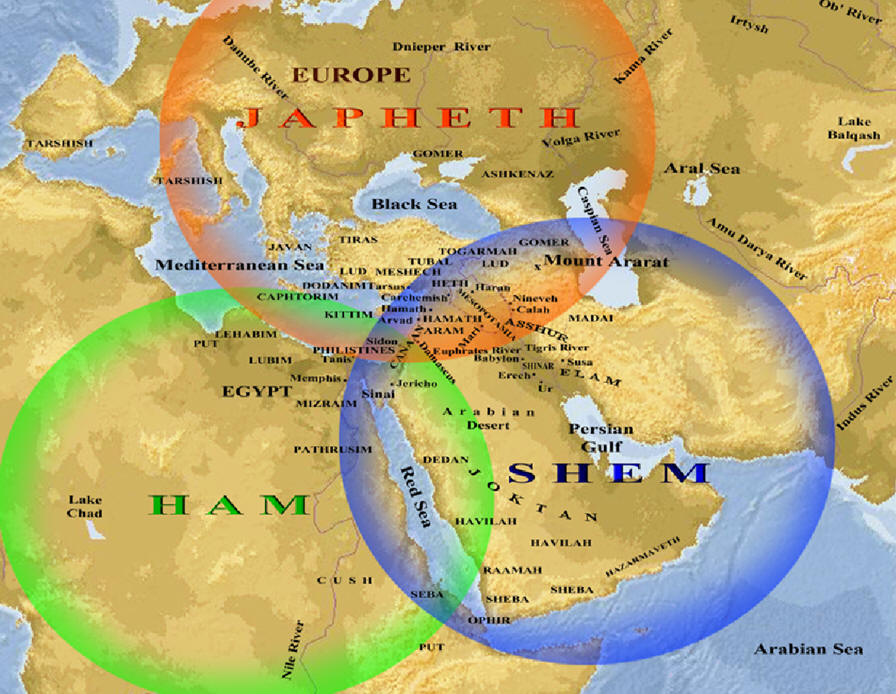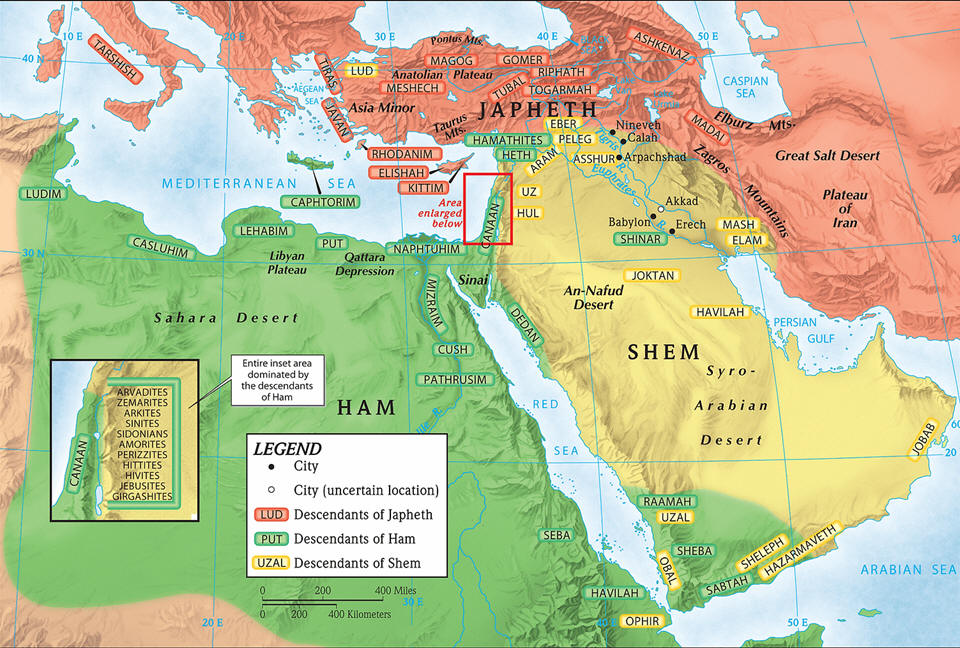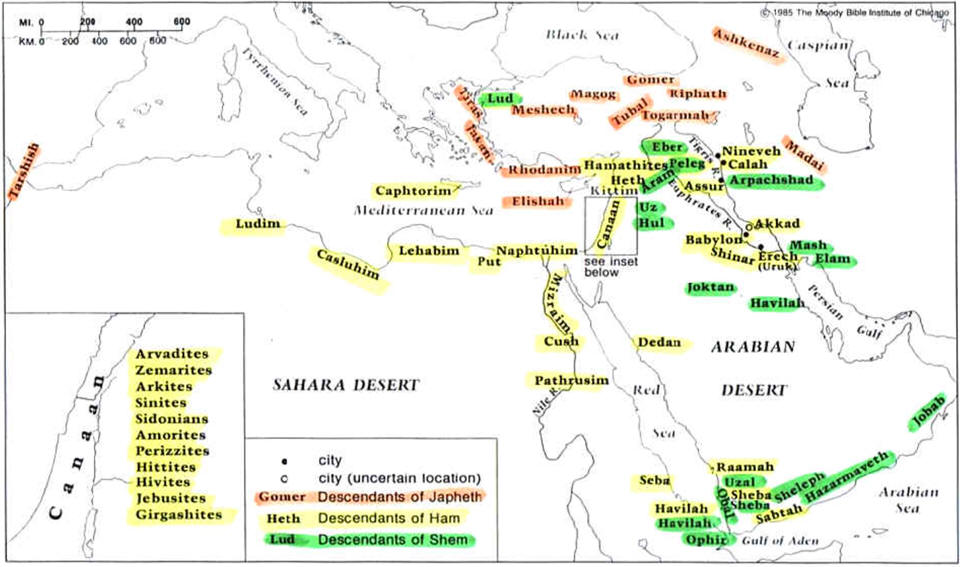Genesis Chapter
10 “Table of Nations”
Please note unlike my
well-referenced sources my content may contain errors and
omissions so please be cautious if using for external
educational purposes. If you find errors or have comments I am
happy to hear from you by e-mail at bottom of any page.
The
Generations of Noah, also called the Table of Nations is a
genealogy of the sons of Noah, Japheth, Ham, and Shem, according
to the Hebrew Bible Genesis 10 and their dispersion into many
lands after the Flood. It shows how God preserved the human race
through Noah and his family and how they repopulated the earth.
The genealogy also highlights the different nations that
descended from each son of Noah which helps to explain the
diversity of cultures and languages in the world today. The
accuracy of the genealogy of the sons of Noah in Genesis is a
matter of debate among historians and scholars. Some argue that
it provides an accurate account of the generations following the
flood while others believe that it may contain some inaccuracies
or omissions due to its oral tradition origins. However, many
historians agree that this genealogy serves as an important
historical document for understanding ancient Near Eastern
history and culture.
The following is a summary of the
descendants at a high level for Japheth, Ham, and Seth. Please
understand rabbinic sources claim much more detail I DO NOT EVEN
ATTEMPT TO TRY AND SUMMARIZE! "Midrash ha-Gadol” "The total
number of the countries was 104; of islands, 99; of languages,
72; and of scripts, 16. To the share of Japheth fell 44
countries, 33 islands, 22 languages, and 5 scripts; Ham received
34 countries, 33 islands, 24 languages, and 5 scripts; Shem, 26
countries, 33 islands, 26 languages, and 6 scripts." The sons of
Shem were not identified by the Rabbis because they were known,
only the following places are given: Arthasia (city in
Phenicia); Gebalene (in Idumea); Acra (in the Lebanon); Aradno
(in Phenicia); Emesa (in Syria); Epiphania (in Syria); Callirhoe
(to the east of the Dead Sea); Sidon; Tripoli (Phenicia);
Cyprus.
Japheth (Son Noah) ► Europe
The 7 sons: 1) Gomer (The Cimmerians) North and South of Black and Caspian Sea, Russia, Persia, Greece, Turkey, Slavs, later Germany, France, Spain, Britain, possibly Africa, 2) Magog (The Scythians) lived north of the Caspian Sea, Russia, 3) Madai (The Medes) settled south of the Caspian Sea, 4) Javan (The Ionians or Greeks), 5) Tubal (The Turks) lived south of the Black Sea, 6) Meschech (The Slavs) lived between the Black and Caspian Seas, and 7) Tiras (The Etruscans) were west of the Black Sea. “North” = cold
|
|
|
|
|
|
|
|
|
|
|
|
|
|
|
|
|
|
|
|
|
|
|
|
|
|
|
|
|
|
|
|
|
|
|
|
|
|
|
|
|
|
|
|
|
|
|
|
|
|
|
|
|
|
|
|
|
|
|
|
|
|
|
|
|
|
|
|
|
|
|
|
|
|
||||||
|
|
|
|
|
|
|
|
|
|
|
|
|
|
|
|
|
|
|
|
|
|
|
|
|
|
|
|
|
|
|
|
|
|
||||||
|
|
|
|
|
|
|
|
|
|
|
|
|
|
|
|
|
|
|
|
|
|
|
|
|
|
|
|
|
|
|
|
|
|
|
|
|
|
|
|
|
|
|
|
|
|
|
|
|
|
|
|
|
|
|
|
|
|
|
|
|
|
|
|
|
|
|
|
|
|
|
|
|
|
|
|
|
|
|
|
|
|
|
|
|
|
|
|
|
|
||||||||||||||||||||||||||||||
|
|
|
|
|
|
|
|
|
|
||||||||||||||||||||||||||||||
|
|
|
|
|
|
|
|
|
|
|
|
|
|
|
|
|
|
|
|
|
|
|
|
|
|
|
|
|
|
|
|
|
|
|
|
|
|
|
|
|
|
|
|
|
|
|
|
|
|
|
|
|
|
|
|
|
|
|
|
|
|
|
|
|
|
|
|
|
|
|
|
|
|
|
|
|
|
|
|
|
|
|
|
|
|
|
|
|
|
|
|
||||||||||||||||||||||||||||
|
|
|
|
|
|
|
|
|
|
|
|
||||||||||||||||||||||||||||
|
|
|
|
|
|
|
|
|
|
|
|
|
|
|
|
|
|
|
|
|
|
|
|
|
|
|
|
|
|
|
|
|
|
|
|
|
|
|
|
Ham (Son Noah) ►Egypt and Africa
The 4 sons :
1) Mizraim (Egypt), 2) Cush (Ethiopia, Mesopotamia), 3) Put
(Libya), and 4) Canaan (Canaan / Phoenicia). “south”=hot.
Shem (Son Noah) ► Mideast
The 4 sons: 1) Elam (Persia), 2) Asshur (Assyria [N. Mesopotamia]), 3) Arpachshad (Babylonia, Ur Chaldees), 4) Lud (Anotolia/Turkey), 5) Aram (Syria). “middle”=not too hot not too col
d.|
|
|
|
|
|
|
|
|
|
|
|
|
|
|
|
|
|
|
|
|
|
|
|
|
|
|
|
|
|
|
|
|
|
||||
|
|
|
|
|
|
|
|
|
|
|
|
|
|
|
|
|
|
|
|
|
|
|
|
|
|
|
|
|
|
|
|
|
|
|
|
|
|
|
|
|
|
|
|
|
|
|
|
|
|
|
|
|
|
|
|
|
|
|
|
|
|
|
|
|
|
|
|
|
|
|
|
|
|
|
|
|
|
|
|
|
|
|
|
|
|
|
|
|
|
|
|
||||||||||||||||||||||
|
|
|
|
|
|
|
|
|
|
|
|
|
|
|
|
|
|
|
|
|
|
|
|
|
|
|
|
|
|
|
|
|
|
|
|
|
|
|
|
|
|
|
|
|
|
|
|
|
|
|
|
|
|
|
|
|
|
|
|
|
|
|
|
|
|
|
|
||||||||
|
|
|
|
|
|
|
|
|
|
|
|
|
|
|
|
|
|
|
|
|
|
|
|
|
|
|
|
|
|
|
|
|
|
|
|
|
|
|
|
|
|
|
|
|
|
|
|
|
|
|
|
|
|
|
|
|
|
|
|
|
|
|
|
|
|
|
|
|
|
|
|
||||
|
|
|
|
|
|
|
|
|
|
|
|
|
|
|
|
|
|
|
|
|
|
|
|
|
|
|
|
|
|
|
|
|
|
|
|
|
|
|
|
|
|
|
|
See
Patriarch Tree for continuation after Peleg |
|
|
|
|
|
|
|
|
|
|
|
|
|
|
|
|
|
|
|
|
|
|
|
|
|||||||
|
|
|
|
|
|
|
|
|
|
|
|
|
|
|
|
|
|
|
|
|
|
||||||||||||||||
|
|
|
|
|
|
|
|
|
|
|
|
|
|
|
|
|
|
|
|
|
|
|
|
|
|
|
|
|
|
||||||||
|
|
|
|
|
|
|
|
|
|
|
|
|
|
|
|
|
|
|
|
|
|
Almodad |
|
|
|
The 13
Tribes Joktan |
|
|
|||||||||
|
|
|
|
|
|
|
|
|
|
|
|
|
|
|
|
|
|
|
|
|
|
|
|
|
|
|
|
|
|
|
|
|
|
|
|
|
|

map is compliments of The Fourth Edition of "The New Oxford Annotated Bible"

Map compliments of
https://michaelmannauthor.com/table-of-nations-shem

Map compliments of
https://djmarko53.wixsite.com/commentary/blank-begva

Map compliments of
https://www.wikiwand.com/en/Elam#Media/File:Elam_Map-en.svg